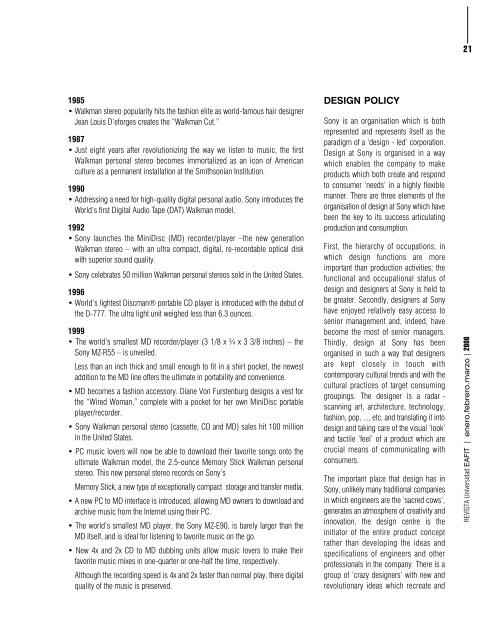Sony Walkman - Universidad EAFIT
Sony Walkman - Universidad EAFIT
Sony Walkman - Universidad EAFIT
You also want an ePaper? Increase the reach of your titles
YUMPU automatically turns print PDFs into web optimized ePapers that Google loves.
1985<br />
• <strong>Walkman</strong> stereo popularity hits the fashion elite as world-famous hair designer<br />
Jean Louis D’eforges creates the “<strong>Walkman</strong> Cut.”<br />
1987<br />
• Just eight years after revolutionizing the way we listen to music, the first<br />
<strong>Walkman</strong> personal stereo becomes immortalized as an icon of American<br />
culture as a permanent installation at the Smithsonian Institution.<br />
1990<br />
• Addressing a need for high-quality digital personal audio, <strong>Sony</strong> introduces the<br />
World’s first Digital Audio Tape (DAT) <strong>Walkman</strong> model.<br />
1992<br />
• <strong>Sony</strong> launches the MiniDisc (MD) recorder/player –the new generation<br />
<strong>Walkman</strong> stereo – with an ultra compact, digital, re-recordable optical disk<br />
with superior sound quality.<br />
• <strong>Sony</strong> celebrates 50 million <strong>Walkman</strong> personal stereos sold in the United States.<br />
1996<br />
• World’s lightest Discman® portable CD player is introduced with the debut of<br />
the D-777. The ultra light unit weighed less than 6.3 ounces.<br />
1999<br />
• The world’s smallest MD recorder/player (3 1/8 x ¾ x 3 3/8 inches) – the<br />
<strong>Sony</strong> MZ-R55 – is unveiled.<br />
Less than an inch thick and small enough to fit in a shirt pocket, the newest<br />
addition to the MD line offers the ultimate in portability and convenience.<br />
• MD becomes a fashion accessory. Diane Von Furstenburg designs a vest for<br />
the “Wired Woman,” complete with a pocket for her own MiniDisc portable<br />
player/recorder.<br />
• <strong>Sony</strong> <strong>Walkman</strong> personal stereo (cassette, CD and MD) sales hit 100 million<br />
in the United States.<br />
• PC music lovers will now be able to download their favorite songs onto the<br />
ultimate <strong>Walkman</strong> model, the 2.5-ounce Memory Stick <strong>Walkman</strong> personal<br />
stereo. This new personal stereo records on <strong>Sony</strong>’s<br />
Memory Stick, a new type of exceptionally compact storage and transfer media.<br />
• A new PC to MD interface is introduced, allowing MD owners to download and<br />
archive music from the Internet using their PC.<br />
• The world’s smallest MD player, the <strong>Sony</strong> MZ-E90, is barely larger than the<br />
MD itself, and is ideal for listening to favorite music on the go.<br />
• New 4x and 2x CD to MD dubbing units allow music lovers to make their<br />
favorite music mixes in one-quarter or one-half the time, respectively.<br />
Although the recording speed is 4x and 2x faster than normal play, there digital<br />
quality of the music is preserved.<br />
DESIGN POLICY<br />
<strong>Sony</strong> is an organisation which is both<br />
represented and represents itself as the<br />
paradigm of a ‘design - led’ corporation.<br />
Design at <strong>Sony</strong> is organised in a way<br />
which enables the company to make<br />
products which both create and respond<br />
to consumer ‘needs’ in a highly flexible<br />
manner. There are three elements of the<br />
organisation of design at <strong>Sony</strong> which have<br />
been the key to its success articulating<br />
production and consumption.<br />
First, the hierarchy of occupations, in<br />
which design functions are more<br />
important than production activities; the<br />
functional and occupational status of<br />
design and designers at <strong>Sony</strong> is held to<br />
be greater. Secondly, designers at <strong>Sony</strong><br />
have enjoyed relatively easy access to<br />
senior management and, indeed, have<br />
become the most of senior managers.<br />
Thirdly, design at <strong>Sony</strong> has been<br />
organised in such a way that designers<br />
are kept closely in touch with<br />
contemporary cultural trends and with the<br />
cultural practices of target consuming<br />
groupings. The designer is a radar -<br />
scanning art, architecture, technology,<br />
fashion, pop, ..., etc, and translating it into<br />
design and taking care of the visual ‘look’<br />
and tactile ‘feel’ of a product which are<br />
crucial means of communicating with<br />
consumers.<br />
The important place that design has in<br />
<strong>Sony</strong>, unlikely many traditional companies<br />
in which engineers are the ‘sacred cows’,<br />
generates an atmosphere of creativity and<br />
innovation, the design centre is the<br />
initiator of the entire product concept<br />
rather than developing the ideas and<br />
specifications of engineers and other<br />
professionals in the company. There is a<br />
group of ‘crazy designers’ with new and<br />
revolutionary ideas which recreate and<br />
21<br />
REVISTA <strong>Universidad</strong> <strong>EAFIT</strong> | enero.febrero.marzo | 2000
















